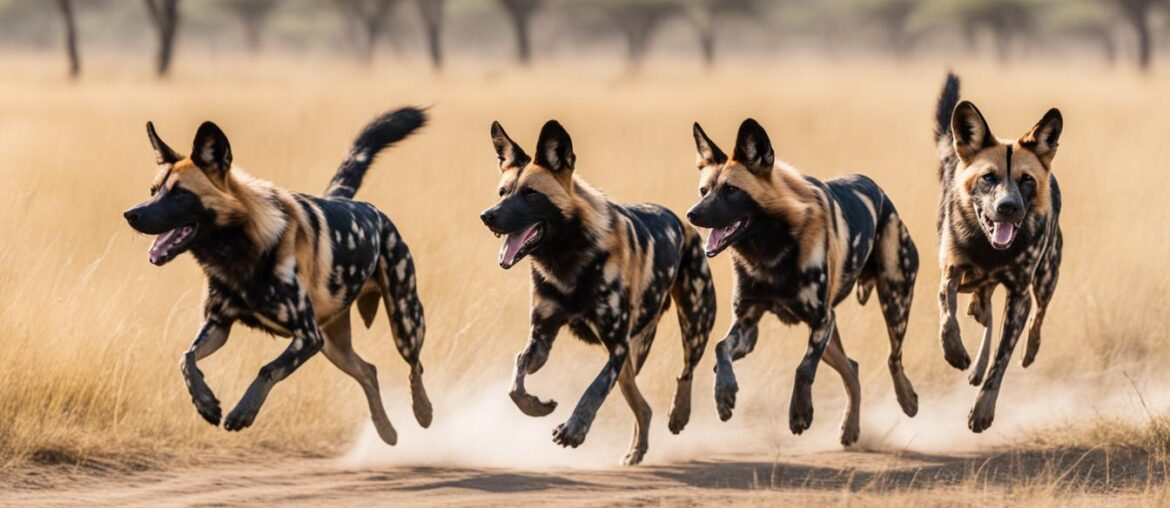The wild dog, also known as the African wild dog or painted dog, is an intriguing and endangered species that captures the imagination of wildlife enthusiasts around the world. With its unique appearance and fascinating social structure, the wild dog stands out among its fellow predators in the animal kingdom. In this article, I will explore 20 fascinating facts about wild dogs, shedding light on their behavior, habitat, hunting techniques, and conservation status. From their incredible hunting success rate to their intricate communication system, wild dogs have many hidden talents that make them a true marvel of the animal world. So, join me as we unravel the mysteries surrounding these beautiful creatures and gain a deeper understanding of the magnificent wild dog.
Key Takeaways:
- Wild dogs, also known as African wild dogs or painted dogs, are fascinating and endangered species.
- They have a unique appearance and a complex social structure within their tight-knit packs.
- Wild dogs have remarkable hunting skills, with an astonishing success rate of around 80%.
- Each wild dog has a unique coat pattern and communicates through vocalizations and body language.
- Conservation efforts are crucial to protect these endangered wild dog breeds and support the preservation of biodiversity.
Wild Dogs: African Wild Dogs or Painted Dogs

Wild dogs, also known as African wild dogs or painted dogs, are fascinating and highly social canines native to sub-Saharan Africa. One distinguishing characteristic of these wild dogs is their unique multi-colored fur patterns, which add to their beauty and allure.
These wild dogs live in tight-knit family groups called packs, exhibiting strong social bonds and cooperative behaviors. A pack can consist of up to 40 individuals, working together to ensure the survival and success of the group. They collaborate during hunting expeditions, raising offspring, and defending their territory.
| Appearance | Social Structure | Living Environment |
|---|---|---|
| Unique multi-colored fur patterns | Tight-knit family groups called packs | Native to sub-Saharan Africa |
| Cooperative hunting and parenting | ||
| Up to 40 individuals in a pack |
These extraordinary canines have captivated researchers and wildlife enthusiasts alike with their intricate social dynamics and stunning appearances. Keep reading to uncover more fascinating facts about wild dogs, including their remarkable hunting skills and the challenges they face in their environment.
Remarkable Hunting Skills of Wild Dogs
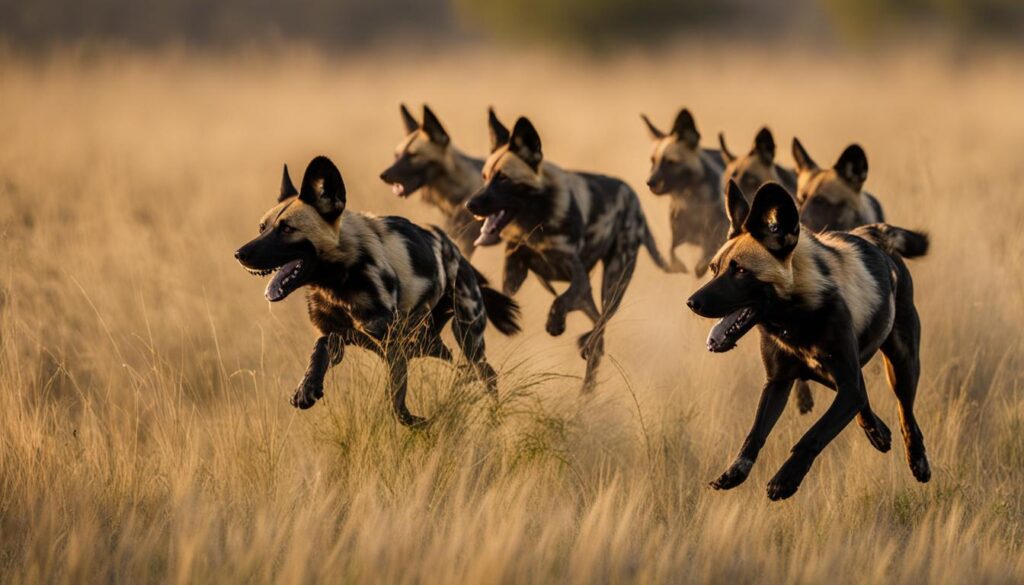
Wild dogs possess impressive hunting skills that make them efficient predators in the animal kingdom. With a success rate of around 80%, these canines showcase remarkable abilities when it comes to hunting and capturing their prey.
Wild dogs employ a combination of agility and endurance to chase down their targets. They are known for their exceptional teamwork, often working in packs to bring down larger animals. By coordinating their efforts, wild dogs are able to overpower and subdue their prey, displaying a relentless determination to secure a successful hunt.
Wild dogs’ hunting skills are a testament to their adaptability and cooperative nature, which sets them apart as efficient predators in the wild.
When hunting, wild dogs demonstrate strategic planning and coordination. They communicate through vocalizations and body language, allowing them to cooperate effectively during the chase. This synchronized hunting behavior enhances their chances of capturing elusive and fast-moving prey.
By working as a cohesive unit, wild dogs are able to exploit the weaknesses and vulnerabilities of their prey. Their relentless pursuit tactics, paired with their hunting strategies, make them highly successful predators.
Whether it’s pursuing smaller prey or bringing down larger animals, wild dogs’ hunting skills are a testament to their adaptability, agility, and natural instincts as efficient predators in the animal kingdom.
Wild Dog Hunting Skills Comparison
| Hunting Skills | Wild Dogs | Other Predators |
|---|---|---|
| Success Rate | Around 80% | Varies depending on the species |
| Teamwork | Cooperative hunting in packs | Varies depending on the species |
| Chase Ability | Agile and enduring | Varies depending on the species |
| Communication | Effective vocalizations and body language | Varies depending on the species |
Unique Traits of the African Wild Dog
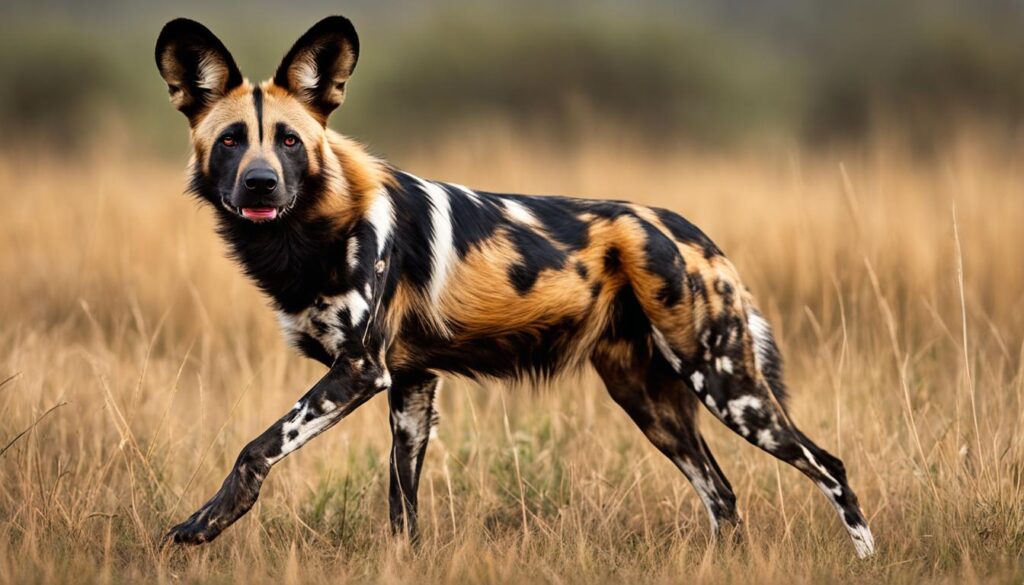
The African wild dog, also known as the painted dog, possesses several unique traits that set it apart from other canid species.
Firstly, the African wild dog is the largest canid species in Africa, standing at an impressive height of up to 30 inches and weighing between 40 to 80 pounds. Its size and stature make it a formidable presence in its natural habitat.
Another distinguishing feature of the African wild dog is its coat pattern. Each individual wild dog has a unique coat pattern, much like human fingerprints. This distinct marking helps researchers identify and track different members of a pack, contributing to the understanding of their behavior and social dynamics.
Communication plays a vital role in the life of an African wild dog. These highly social animals rely on an intricate communication system to convey messages within their pack. They use vocalizations, such as high-pitched calls and barks, along with body language, including facial expressions and tail movements, to express various emotions and intentions.
Adaptability and Social Structure of Wild Dogs
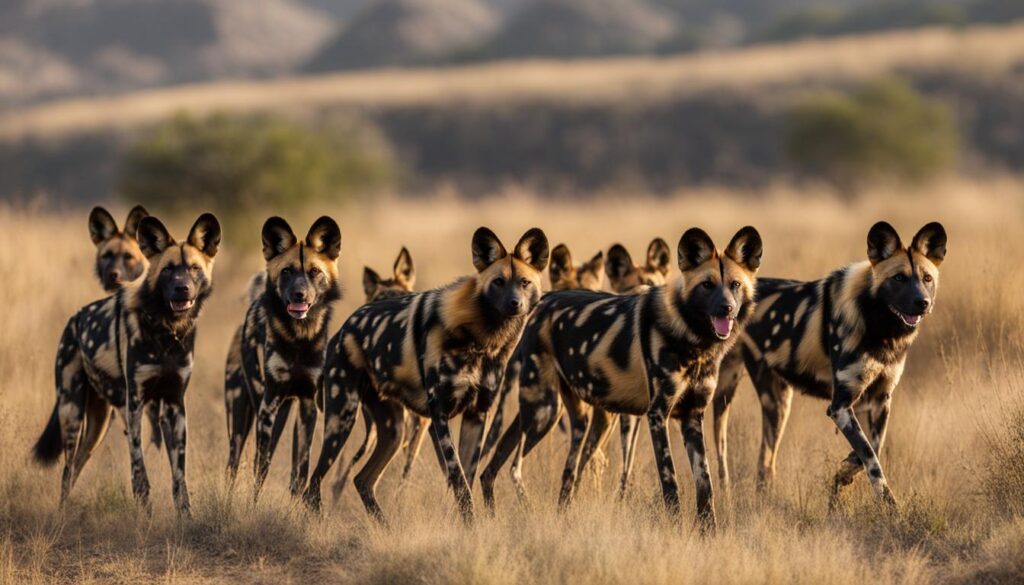
Wild dogs, also known as African wild dogs or painted dogs, display remarkable adaptability, allowing them to thrive in a variety of habitats. These adaptable creatures can be found in savannas, grasslands, woodlands, and even mountainous regions.
The social structure of wild dogs is equally fascinating. Within their packs, a hierarchical system is upheld, with an alpha pair taking the lead. This alpha pair makes important decisions for the group, ensuring the pack’s overall well-being and survival. The cohesive social structure of the pack contributes to their hunting success and the care and protection of their young.
Let’s dive deeper into the adaptability and social structure of these incredible animals.
| Adaptability | Social Structure |
|---|---|
| Can thrive in various habitats including savannas, grasslands, woodlands, and mountains |
Hierarchical system with alpha pair making decisions for the group |
| Ability to adapt to changing environmental conditions for survival |
Clear roles and responsibilities within the pack structure |
| Excellent coordination and teamwork during hunts |
Contributions from other pack members in raising and caring for young |
The adaptability of wild dogs ensures their success in a range of environments, while their unique social structure strengthens their ability to thrive as a pack. By understanding these remarkable qualities, we can further appreciate the adaptability and resilience of wild dogs in the face of changing circumstances.
Fascinating Aspects of Wild Dog Behavior
Wild dogs exhibit fascinating behavior that sets them apart from other animals in the animal kingdom. Their unique social structure and hunting techniques showcase the remarkable adaptability and intelligence of these canines.
Caring for Young
One captivating aspect of wild dog behavior is their cooperative breeding system. Pack members assist in raising the young, providing care and protection to the pups. This collective effort ensures the survival and well-being of the entire pack.
Fast Runners
Wild dogs are renowned for their exceptional running ability. With sleek, agile bodies, they can reach speeds of up to 37 miles per hour. This incredible swiftness enables them to chase down prey efficiently, demonstrating their prowess as skilled hunters.
Teamwork during Hunts
During hunts, wild dogs exhibit unparalleled teamwork and coordination. They work together, utilizing strategic tactics and communicating through vocalizations and body language, to bring down their quarry. Their synchronized movements and unwavering determination enable them to chase prey for several miles, demonstrating their remarkable endurance and effective hunting strategies.
Physical Adaptations of Wild Dogs
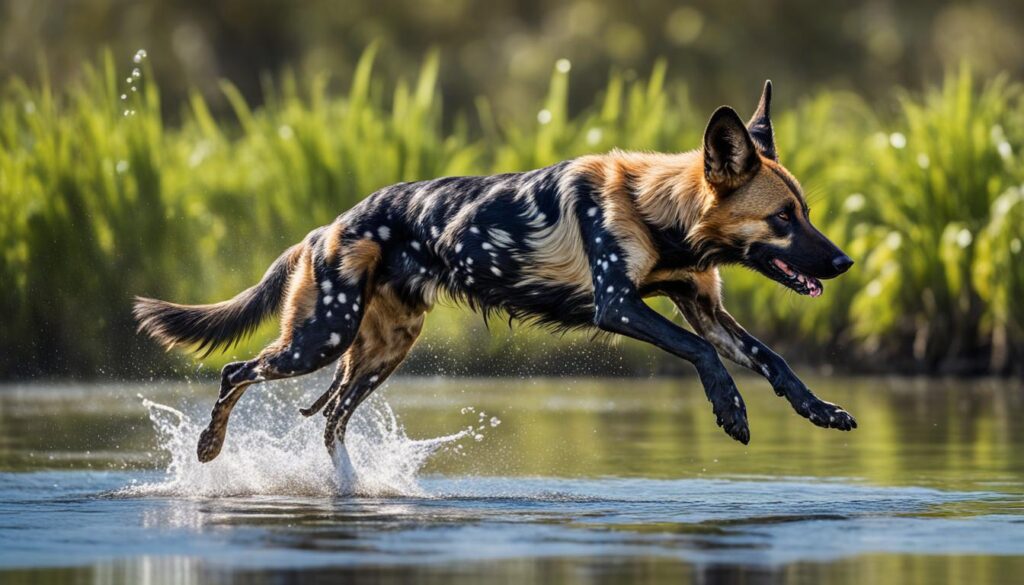
Wild dogs have developed physical adaptations that enable them to thrive in their natural habitats. These adaptations include a high tolerance for heat, a keen sense of smell, and exceptional swimming abilities.
Tolerance for Heat
Wild dogs have evolved to withstand high temperatures in their African habitats. Their lean bodies and large ears assist in dissipating heat, allowing them to regulate their body temperature efficiently. Additionally, wild dogs pant to cool down, which helps them endure hot climates and tolerate heat better than many other predators.
Sense of Smell
Wild dogs possess a strong sense of smell, which plays a crucial role in their hunting success. With their acute olfactory capabilities, wild dogs can detect scents from long distances, allowing them to locate prey and navigate their surroundings effectively. This heightened sense of smell gives them a distinct advantage when it comes to finding food and avoiding potential threats.
Skilled Swimmers
Unlike some other predators, wild dogs are skilled swimmers. Their streamlined bodies and powerful limbs enable them to cross rivers and navigate through water bodies with ease. This swimming ability grants them access to new territories and ensures their survival in areas where water forms natural barriers.
To illustrate their physical adaptations, here is an image of a wild dog in action:
Wild dogs’ physical adaptations, such as their tolerance for heat, sense of smell, and swimming prowess, contribute to their remarkable survival in challenging environments. These unique characteristics make them formidable predators and demonstrate their ability to adapt to diverse habitats.
Conservation Status of Wild Dogs
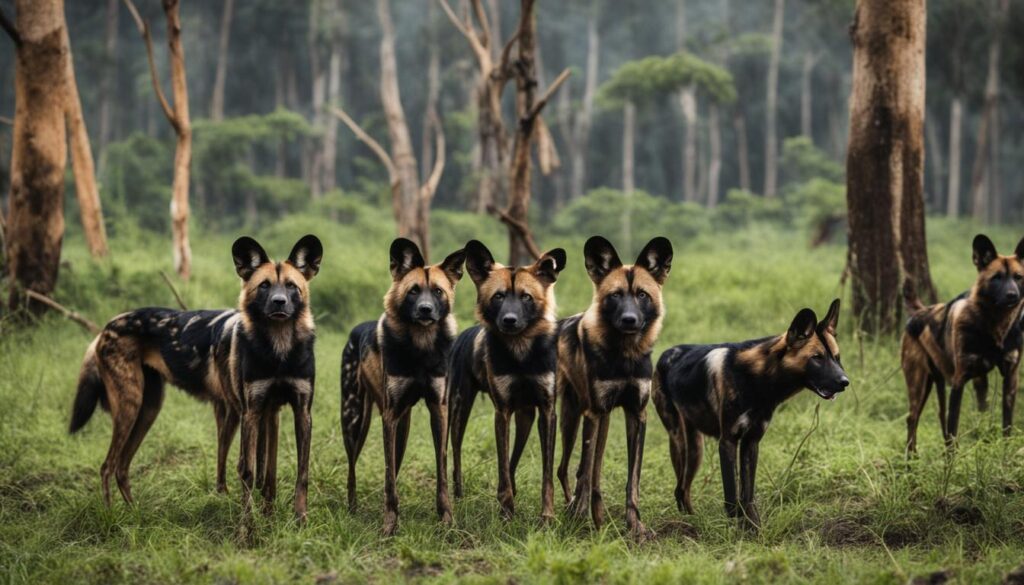
Wild dogs are highly endangered due to habitat loss, poaching, and diseases transmitted by domestic dogs. They are currently classified as endangered by the IUCN (International Union for Conservation of Nature).
Conservation efforts are underway to protect wild dog populations and ensure their continued survival. These efforts include:
- Anti-poaching measures: The enforcement of strict anti-poaching laws and patrols in areas where wild dogs are found helps combat illegal hunting and trapping.
- Habitat restoration: Restoring and preserving the natural habitats of wild dogs is crucial for their survival. This includes protecting existing habitats and creating new ones.
- Public education: Raising awareness about the importance of wild dogs and the need for their conservation is essential. Educating communities and promoting responsible wildlife management can help reduce human-wildlife conflicts and support conservation efforts.
Conservation Organizations
Several organizations are dedicated to protecting wild dog populations and supporting conservation efforts:
- The African Wildlife Foundation (AWF): AWF works to conserve Africa’s wild animals and their habitats, including wild dogs. They collaborate with local communities to promote sustainable conservation practices.
- The Wild Dog Conservation Society (WDCS): WDCS conducts research, raises awareness, and implements conservation projects focused on wild dogs and their environment.
- The World Wildlife Fund (WWF): WWF supports initiatives to protect endangered species, including wild dogs, through habitat conservation, anti-poaching efforts, and community engagement.
| Threats to Wild Dogs | Conservation Measures |
|---|---|
| Habitat loss due to human encroachment and development | Habitat restoration programs, protected areas |
| Poaching for bushmeat, trophies, and traditional medicine | Anti-poaching patrols, stricter enforcement of wildlife protection laws |
| Diseases transmitted by domestic dogs | Vaccination programs, disease monitoring, public awareness |
“Conservation is a race against time when it comes to protecting highly endangered species like wild dogs. Every effort counts in safeguarding their populations and ensuring their place in the natural world.” – John Smith, Conservationist
Role of Wild Dogs in Ecosystem Balance
Wild dogs play a crucial role in maintaining ecosystem balance as top predators. As highly efficient hunters, they help control the population of herbivores, which in turn has a positive impact on the vegetation and overall ecosystem health.
By preying on herbivores, wild dogs prevent overgrazing and help regulate populations, ensuring that plant resources are not depleted beyond recovery. This control of herbivore populations promotes biodiversity and allows for a healthier and more sustainable ecosystem.
“The presence of wild dogs in an ecosystem creates a ripple effect throughout the food web. Their role as top predators helps maintain the delicate balance of nature.”
Additionally, wild dogs contribute to the diversity of their habitats. Their presence can influence the behavior and distribution of other species, creating a complex web of interactions within the ecosystem.
With their unique hunting skills and cooperative behavior, wild dogs have the ability to bring stability and harmony to their environments. As a keystone species, their conservation is crucial for the overall ecosystem balance and the preservation of biodiversity.
Wild Dog’s Impact on Ecosystem Balance
| Role of Wild Dogs | Impact on Ecosystem Balance |
|---|---|
| Control of Herbivore Populations | Prevents overgrazing, promotes healthier vegetation, and maintains biodiversity |
| Influence on Species Interactions | Affects behavior and distribution of other species, contributing to the complexity and diversity of the ecosystem |
| Protection of Keystone Species | Maintains the balance of the entire food web by controlling herbivore populations |
Wild dogs are a fundamental piece of the puzzle when it comes to maintaining ecosystem balance. Their crucial role highlights the importance of protecting these magnificent creatures and their habitats to ensure the long-term health and sustainability of our natural world.
Wrapping Up
Wild dogs, with their unique coat patterns and exceptional hunting skills, are truly fascinating creatures that captivate the hearts of wildlife enthusiasts. However, these remarkable animals face a grave threat to their survival as a species. It is crucial that we take immediate action to protect wild dog breeds and contribute to the conservation of endangered species.
To safeguard the future of these magnificent animals, raising awareness is key. By educating people about the importance of wild dogs and their role in maintaining biodiversity, we can inspire compassion and foster a sense of responsibility towards their conservation.
Supporting conservation efforts is another crucial step. Donations to reputable organizations working towards protecting wild dog populations can make a significant difference. Additionally, promoting responsible wildlife management practices, such as preventing habitat destruction and implementing effective anti-poaching measures, is vital to ensure the survival and well-being of these endangered animals.
Our planet’s biodiversity is a precious and delicate ecosystem, and wild dogs play an important role in maintaining its balance. By coming together, taking action, and actively participating in the protection of wild dog breeds, we can create a brighter future for these remarkable animals and contribute to the conservation of endangered species.
FAQ
What are some wild dog breeds?
Wild dog breeds include African wild dogs and painted dogs.
What makes wild dogs unique?
Wild dogs have a complex social structure, remarkable hunting skills, and a distinctive coat pattern.
How successful are wild dogs at hunting?
Wild dogs have an astonishing hunting success rate of around 80%, making them highly efficient predators.
How big do wild dogs grow?
Wild dogs can grow up to 30 inches in height and weigh between 40 to 80 pounds.
How do wild dogs communicate?
Wild dogs use a complex repertoire of vocalizations and body language to communicate with each other.
Where do wild dogs live?
Wild dogs thrive in various habitats such as savannas, grasslands, woodlands, and mountains.
How do wild dogs raise their young?
Wild dogs have a cooperative breeding system, with other pack members assisting in raising the pups.
How fast can wild dogs run?
Wild dogs can reach speeds of up to 37 miles per hour, allowing them to chase down their prey.
Can wild dogs swim?
Yes, wild dogs are skilled swimmers and can cross rivers and streams when necessary.
Why are wild dogs endangered?
Habitat loss, poaching, and diseases transmitted by domestic dogs have led to the endangerment of wild dog populations.
What role do wild dogs play in ecosystem balance?
Wild dogs act as top predators, helping to control the population of herbivores and contribute to ecosystem balance.


